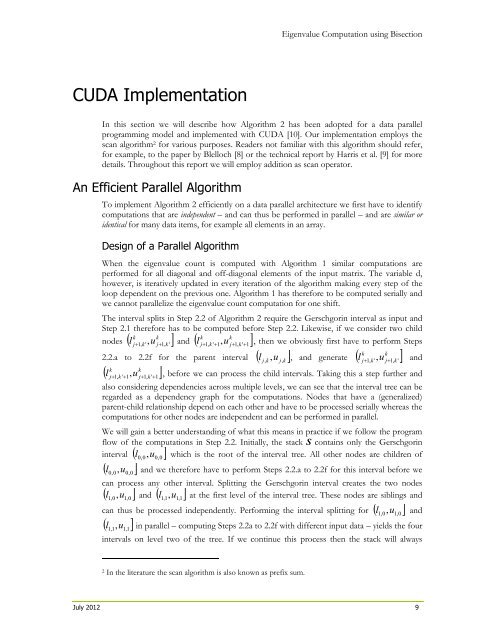Christian Lessig
SORtc
SORtc
- No tags were found...
Create successful ePaper yourself
Turn your PDF publications into a flip-book with our unique Google optimized e-Paper software.
Eigenvalue Computation using Bisection<br />
CUDA Implementation<br />
In this section we will describe how Algorithm 2 has been adopted for a data parallel<br />
programming model and implemented with CUDA [10]. Our implementation employs the<br />
scan algorithm 2 for various purposes. Readers not familiar with this algorithm should refer,<br />
for example, to the paper by Blelloch [8] or the technical report by Harris et al. [9] for more<br />
details. Throughout this report we will employ addition as scan operator.<br />
An Efficient Parallel Algorithm<br />
To implement Algorithm 2 efficiently on a data parallel architecture we first have to identify<br />
computations that are independent – and can thus be performed in parallel – and are similar or<br />
identical for many data items, for example all elements in an array.<br />
Design of a Parallel Algorithm<br />
When the eigenvalue count is computed with Algorithm 1 similar computations are<br />
performed for all diagonal and off-diagonal elements of the input matrix. The variable d,<br />
however, is iteratively updated in every iteration of the algorithm making every step of the<br />
loop dependent on the previous one. Algorithm 1 has therefore to be computed serially and<br />
we cannot parallelize the eigenvalue count computation for one shift.<br />
The interval splits in Step 2.2 of Algorithm 2 require the Gerschgorin interval as input and<br />
Step 2.1 therefore has to be computed before Step 2.2. Likewise, if we consider two child<br />
k k<br />
k k<br />
nodes l<br />
j 1 , k'<br />
, u<br />
j1,<br />
k'<br />
and l j<br />
1 , k'<br />
1, u<br />
j1,<br />
k'<br />
1, then we obviously first have to perform Steps<br />
k k<br />
2.2.a to 2.2f for the parent interval u <br />
l<br />
j 1 , k'<br />
, u<br />
j1,<br />
k'<br />
and<br />
<br />
k k<br />
l<br />
j<br />
1 , k'<br />
1, u<br />
j1,<br />
k'<br />
1<br />
<br />
l<br />
j k j,<br />
k<br />
,<br />
, , and generate <br />
, before we can process the child intervals. Taking this a step further and<br />
also considering dependencies across multiple levels, we can see that the interval tree can be<br />
regarded as a dependency graph for the computations. Nodes that have a (generalized)<br />
parent-child relationship depend on each other and have to be processed serially whereas the<br />
computations for other nodes are independent and can be performed in parallel.<br />
We will gain a better understanding of what this means in practice if we follow the program<br />
flow of the computations in Step 2.2. Initially, the stack S contains only the Gerschgorin<br />
interval l 0 ,0,u0,0<br />
which is the root of the interval tree. All other nodes are children of<br />
l 0 ,0,u0,0<br />
and we therefore have to perform Steps 2.2.a to 2.2f for this interval before we<br />
can process any other interval. Splitting the Gerschgorin interval creates the two nodes<br />
l 1 ,0,u1,0<br />
and l 1 ,1,u1,1<br />
at the first level of the interval tree. These nodes are siblings and<br />
can thus be processed independently. Performing the interval splitting for l 1 ,0,u1,0<br />
and<br />
l 1 ,1,u1,1<br />
in parallel – computing Steps 2.2a to 2.2f with different input data – yields the four<br />
intervals on level two of the tree. If we continue this process then the stack will always<br />
2 In the literature the scan algorithm is also known as prefix sum.<br />
July 2012 9


